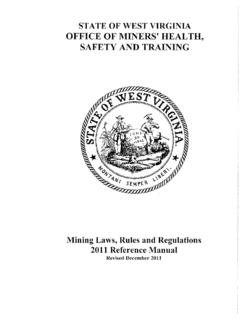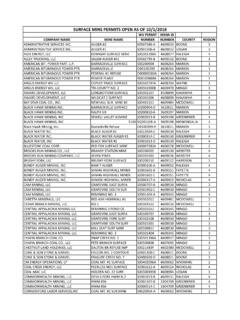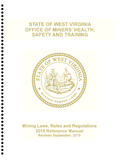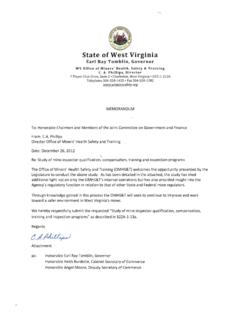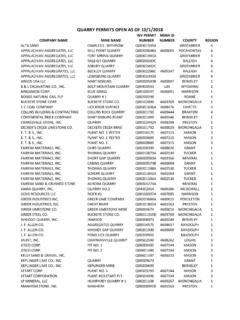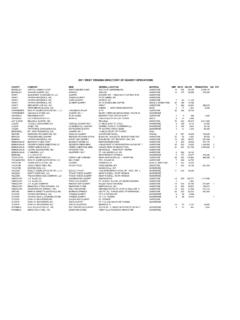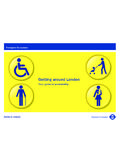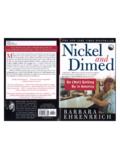Transcription of 80 HOUR Underground Miner Pre-Employment …
1 WEST VIRGINIA OFFICE OF MINERS HEALTH, SAFETY AND training 80 hour Underground Miner Pre-Employment training Program Study guide Unit 1 Three Types of Underground Coal Mines: (1) Shaft mines - Opening goes straight down to the coal seam. (2) Drift mines - Opening goes directly back into the seam of coal where the coal has outcropped. (3) Slope mines - Opening slants down to the coal seam. Note: Once you reach the seam of coal the mining methods are the same. Mining Methods: A. Continuous - A section where a continuous Miner is being used to remove the coal. B. Conventional - At least five (5) faces must be provided and the coal has to be blasted loose from a solid face. C. Longwall - Sheer or plow is used to mine a block of coal usually with a four hundred to six hundred (400 600) feet face (Or more) four thousand to six thousand (4,000 6,000) feet long; roof is supported by chocks.
2 D. Bridgewall - Where an extensible belt is connected to the continuous Miner and belt transports coal to the main section belt; the extensible belt replaces shuttle car coal transportation. E. Shortwall - Using a continuous Miner to extract blocks of coal with chocks as the main means of supporting the roof. Definitions: Inby - This means closer to the face than a comparing point. Outby - This means further away from the face than a comparing point. Note: Usually the end of the belt or the last open crosscut will be used as comparing points. Example: A C B ACDBEFGCCE levator ShaftBelt Point A is inby the last open crosscut because it is closer to the face than the last open crosscut.
3 Point B is outby the end of the belt because it is father away from the face than the end of the belt. Point C is outby the last open crosscut because it is further away from the face than the last open crosscut, but inby the end of the belt because it is closer to the end of the belt. Mining Terms: A. Crosscut - Passageways used to connect entries. B. Entry - Passageways leading to the face. C. Face - Actual place where coal is being removed. D. Gob - Caved in area in the mine usually after pillars have been removed. E. High coal - According to this material, anything over 36 inches is high coal. NOTE: Most coal miners consider high coal anything over four (4) feet. F. Low coal - Thirty-six (36) inches and lower according to this material. G. Pillar - Blocks or pillars of coal left behind in development mining supporting the main roof.
4 These blocks are usually removed in retreat mining or pillaring allowing the roof to cave forming the gob. H. Portal - The opening of a shaft, drift, or slope mine. NOTE: Sometimes the opening to a drift mine is called a driftmouth. I. Pillaring - (Retreat mining) Removing the blocks or pillars of coal that were left during development mining work in which the roof falls to become the gob. J. Rib - The sides (walls) of an Underground mine. K. Roof - (Top) The material overhead in an Underground coal mine. NOTE: There can be many kinds of roof in mines some good, some bad.
5 L. Room - The area from the last open crosscut to the face. M. Section - The place in a mine where an entire crew of men are working and mining coal. NOTE: There are usually many sections in an Underground mine depending on the size of the mine. FACE FACE FACE FACE ROOM ROOM ROOM ROOM Crosscut Crosscut Crosscut E Pillar E Pillar E Pillar E N N N N T T T T R R R R Y Y Y Y Pillar Pillar Pillar Note: Entries are numbered from left to right.
6 Note: This whole area would be called a section. You need to know how to recognize all the mining machines. Unit 2 Self Rescuer: Two (2) models: A. W-65 is in a stainless steel case. B. Drager 810 is in a plastic carrying case. Both models function basically the same. Important things to remember about the self rescuer: A. Issued by the company. B. Should be worn in the Underground miners belt at all times. C. Retraining classes in the use of the self rescuer must be conducted every year. D. Once the seal is broken it will give the wearer one (1) hour protection. E. Should be used at the first indication of smoke or fire. F. Principle purpose is to change carbon monoxide (CO) to carbon dioxide (CO2). G. Provided the seal is not broken the belt life of carrying time is five (5) years. H. When in use mouth piece will heat up; under no circumstances should it be removed from your mouth. I. The W-65 can be checked for air tightness by submerging it in water; if air bubbles appear it should be exchanged for a new one.
7 The Drager 810 should NOT be tested for air tightness by submerging it in water. NOTE: These self rescuers have to be weighted every ninety (90) days, if they should gain more than ten (10) grams from their original weight, they have to be replaced. The student should know all the personal safety equipment necessary for entry into an Underground mine. Battery cap light check: If the indicator or needle points to the ON position the battery is not charged and should not be taken Underground . If the indicator points to the OFF position the battery is charged and ready for use. Definition of Terms: A. Mine Emergency Plan - A plan of what those on the surface will do and what those Underground will do in the event of an emergency. Underground emergency plan: (1) Recognize the emergency exists. (2) Report nature and location of emergency. (3) Try to escape from dangerous area. (4) If escape is cut off then the final step is to barricade.
8 B. Check In, Check Out Procedure: A quick way to determine who is in the mine in the event of a mine emergency (time clock, lamp check, tag, etc.) C. Tram - The moving of self propelled equipment from one place to another other than track equipment. D. Dangerboard - A sign used to warn miners from entering dangerous areas in the mines; no one is allowed to cross a dangerboard unless accompanied by a foreman with the intent of correcting the dangerous condition. F. Shelterholes or - Places in the rib along track haulageways for workers to get Manholes when track equipment is moving along the track. Shelterholes are on the clearance side and spaced no farther than one hundred (100) feet apart.
9 Riding Mantrips: Open Trips: A. Make sure trip is stopped before getting on and off. B. Board and ride on opposite side of the trolley wire. C. Face the direction of travel. D. Keep seated in bottom of car with all parts of body confined inside of car. E. Wear safety glasses. F. Never ride cars with any type of supplies, tools or coal in car. Closed Trips: A. Make sure trip is stopped before getting on or off. B. Keep all parts of body inside of car. Conveyor belts can be used as mantrips but are classified as open mantrips if they meet these requirements: A. Eighteen (18) inches of overhead clearance minimum. B. Automatic cut off switch for entire length of belt. C. Thirty-six (36) inches clearance at loading and unloading points with lighting provided. D. Men shall ride six (6) feet apart. E. Belt speed should not exceed two hundred fifty (250) feet per minute with eighteen (18) inches clearance. Three hundred (300) feet per minute with twenty-four (24) inches overhead clearance and three hundred fifty (350) feet per minute with more than twenty-four (24) inches of overhead clearance.
10 F. Trip riders should lay flat on stomach with arms stretched out in front of them. G. Must wear safety glasses. H. Cross the belt only where suitable crossing facilities are provided. Steps for Crossing the Tracks Safely: A. Walk on the clearance side. B. Look both ways for approaching trips. C. Watch footing to prevent slipping or tripping. D. Watch out for trolley wire. E. Cross where track is straight not on a curve. F. Do not step on the rails. BASIC ELECTRICAL CONCEPT TRAINER The Basic Electrical Concept (BEC) Trainer will allow the instructor to demonstrate the effect of an electrical circuit. He/she will be able to show the conductivity or insulating properties of material by placing them on the insulator/conductor bracket and observing the light. The term ground can be demonstrated by using the ground wire. Parts List 1. Base board. 2. Battery [Two (2) required] six (6) volts. 3. Conductor/Insulator bracket.


